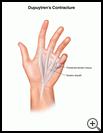
Dupuytren's Contracture
________________________________________________________________________
KEY POINTS
- Dupuytren's contracture is a condition in which thickened tissue in your hand forces one or more of your fingers to bend toward the palm. You can get it in one or both hands.
- Treatment may include physical or occupational therapy, medicines in the joint, or surgery.
- Follow the full course of treatment prescribed by your healthcare provider. Make sure you know when you should come back for a checkup. Keep all appointments for provider visits or tests.
________________________________________________________________________
What is Dupuytren's contracture?
Dupuytren's contracture is a condition in which thickened tissue in your hand forces one or more of your fingers to bend toward the palm. You can get it in one or both hands.
What is the cause?
The cause of Dupuytren's contracture is not known. In most cases, it does not start until after age 40. It tends to be more common in men and runs in families. It is also more common in people of northern European ancestry. Your risk for this problem may be higher if you:
- Are dependent on alcohol
- Smoke
- Take medicine for seizures
- Have diabetes
- Have a job that exposes you to vibration or requires repetitive hand motion
- Had a previous hand injury
What are the symptoms?
A lump, or nodule, develops in the palm of your hand near the base of your ring or little finger. Sometimes the skin on your palm or fingers puckers, forming a dimple. Other nodules may develop and create a cord, or band, that extends from your palm into your finger. This cord tightens and bends your finger toward the palm. It gets hard to straighten your finger. The thickened tissue may pull your finger into a completely bent position. It may get so bad that you cannot use your fingers.
This problem does not usually cause pain.
In some cases, your fingers can become bent within a few weeks or months, but it is more common for a finger to take several years to reach the bent position.
How is it diagnosed?
Your healthcare provider will ask about your symptoms and medical history and examine you. Usually no tests are needed.
How is it treated?
When Dupuytren’s contracture is just starting, it can be treated with:
- Physical therapy to help keep the finger and tendon flexible
- A shot or steroid medicine to help prevent or slow thickening and stiffening of the tissues
- Radiation therapy
Other treatments may include:
- Using a needle to break up the stiff, contracting tissues. First your healthcare provider will numb the area. Then your provider will put a needle through your skin and tear the band of tissues that is making your finger bend.
- Injecting a medicine to soften and weaken the thick tissue causing the contracture. The next day your healthcare provider will move your hand in ways that can break up the softened cords and stretch the fingers into their normal position.
The condition may worsen very slowly, but it will not go away. Your healthcare provider may want to see you every 6 months. If the problem keeps getting worse, or you cannot put your hand flat on a table, your healthcare provider may suggest surgery to cut and remove the thickened tissue in your hand.
If you have surgery, you should not use your hand for several weeks after the procedure. You may have to wear a dressing, cast, or splint for a while. You will likely have physical therapy or occupational therapy for 1 to 2 months after surgery to help get back full use of your finger and hand. Dupuytren's contracture can come back after treatment, but it helps to follow your healthcare provider’s and therapist’s advice for home care and exercises.
How can I take care of myself?
Follow the full course of treatment prescribed by your healthcare provider. Ask your provider:
- If there are activities you should avoid and when you can return to your normal activities
- How to take care of yourself at home
- What symptoms or problems you should watch for and what to do if you have them
Make sure you know when you should come back for a checkup. Keep all appointments for provider visits.

